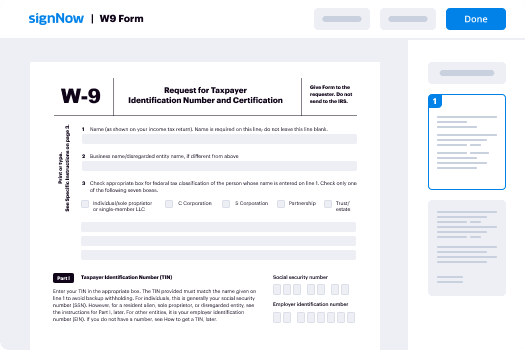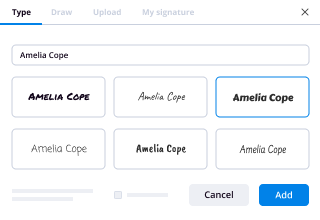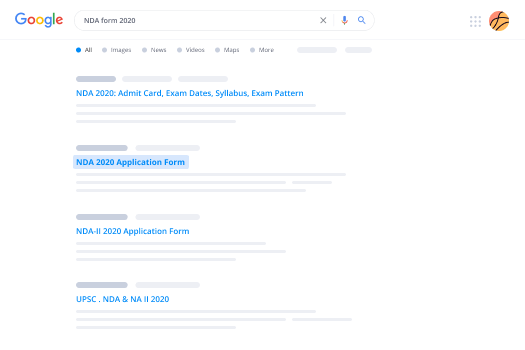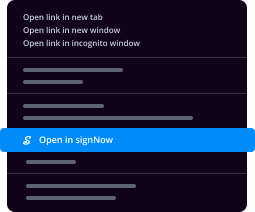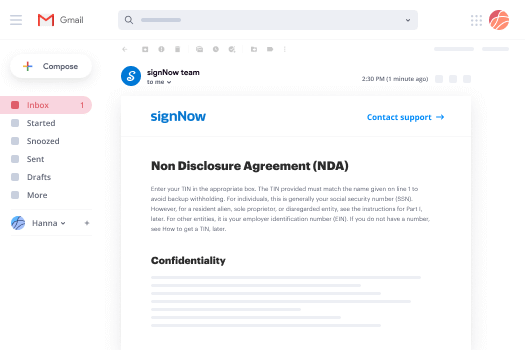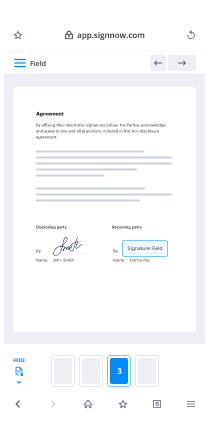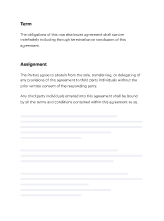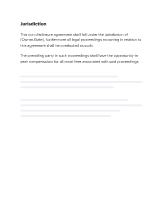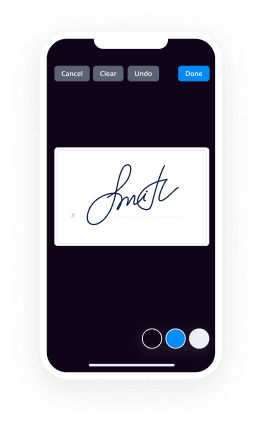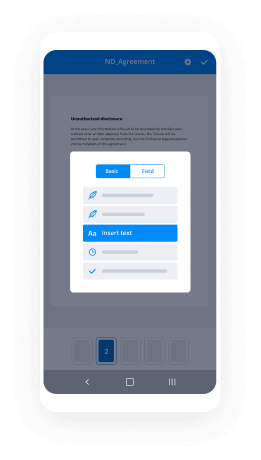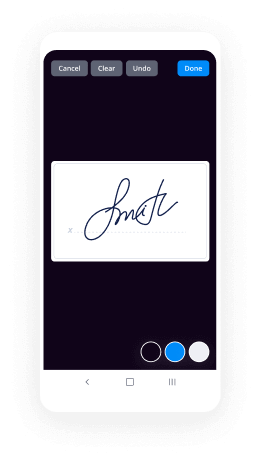Explore La Firma En Línea: Firmar En Papel
- Rápido para iniciar
- Fácil de usar
- Soporte 24/7
Las empresas con visión de futuro de todo el mundo confían en SignNow






Guía rápida sobre cómo firmar en papel
Cada empresa necesita firmas, y cada empresa busca mejorar el proceso de recopilarlas. Obtén una gestión profesional de documentos con airSlate SignNow. Puedes firmar en papel, generar plantillas rellenables, personalizar invitaciones de eSignature, enviar enlaces de firma, colaborar en equipos y más. Aprende cómo mejorar la recolección de firmas digitalmente.
Sigue los pasos que se indican a continuación para firmar en papel en cuestión de minutos:
- Abre tu navegador web y accede a signnow.com.
- Regístrate para una prueba gratuita o inicia sesión utilizando tu correo electrónico o credenciales de Google/Facebook.
- Haz clic en Avatar de Usuario -> Mi Cuenta en la esquina superior derecha de la página.
- Personaliza tu Perfil de Usuario añadiendo datos personales y modificando configuraciones.
- Diseña y gestiona tu(s) Firma(s) Predeterminada(s).
- Regresa a la página del panel de control.
- Pasa el cursor sobre el botón Subir y Crear y selecciona la opción adecuada.
- Haz clic en la opción Preparar y Enviar junto al nombre del documento.
- Ingresa la dirección de correo electrónico y el nombre de todos los firmantes en la ventana emergente que se abre.
- Utiliza el menú Comenzar a añadir campos para comenzar a modificar el documento y firmarlo tú mismo.
- Haz clic en GUARDAR E INVITAR cuando hayas terminado.
- Continúa ajustando tu flujo de trabajo de eSignature utilizando funciones avanzadas.
No podría ser más simple firmar en papel que eso. Además, puedes instalar la aplicación gratuita airSlate SignNow en tu teléfono móvil y acceder a tu cuenta dondequiera que estés sin estar atado a tu computadora u oficina. Ve sin papel y comienza a firmar contratos en línea.
Cómo funciona
Califica tu experiencia
What is the sign in paper
The sign in paper is a document used to record attendance or participation, often in settings such as events, meetings, or classes. It typically includes fields for names, contact information, and timestamps. In a digital context, the sign in paper can be transformed into an electronic format, allowing users to fill out and eSign the document online. This process enhances efficiency and accuracy while ensuring that records are easily accessible and securely stored.
How to use the sign in paper
To use the sign in paper electronically, start by uploading the document to airSlate SignNow. Users can then fill in their information directly on the platform. Once completed, the document can be sent for signature to relevant parties. Recipients can review and sign the document using their own devices, streamlining the process and eliminating the need for physical paperwork.
Steps to complete the sign in paper
Completing the sign in paper electronically involves several straightforward steps:
- Upload the sign in paper to airSlate SignNow.
- Fill in the required fields, such as name and date.
- Review the information for accuracy.
- Send the document to others for their signatures if needed.
- Once all signatures are collected, download or store the completed document securely.
Legal use of the sign in paper
The sign in paper holds legal significance when used to document attendance or participation. In the United States, electronic signatures are recognized under the Electronic Signatures in Global and National Commerce (ESIGN) Act and the Uniform Electronic Transactions Act (UETA). This means that a properly executed electronic sign in paper is legally binding and can be used in court if necessary.
Key elements of the sign in paper
Essential elements of the sign in paper include:
- Name of the individual signing in.
- Date and time of signing.
- Contact information, such as email or phone number.
- Purpose of the sign in, which may include event details or meeting topics.
- Signature field for electronic signing.
Security & Compliance Guidelines
When using the sign in paper electronically, it is crucial to adhere to security and compliance guidelines. This includes ensuring that the platform used for eSigning, like airSlate SignNow, complies with data protection regulations. Documents should be encrypted during transmission, and access should be restricted to authorized users only. Additionally, maintaining an audit trail of all actions taken on the document enhances accountability and transparency.
Digital vs. Paper-Based Signing
Digital signing of the sign in paper offers numerous advantages over traditional paper-based methods. Electronic signatures reduce the time required for document processing, eliminate the need for physical storage, and minimize the risk of loss or damage. Moreover, digital signing enhances accessibility, allowing users to sign from anywhere with an internet connection. This transition not only improves efficiency but also supports environmentally friendly practices by reducing paper consumption.
¡Obtenga ahora firmas vinculantes desde el punto de vista jurídico!
-
Mejor ROI. Nuestros clientes logran un promedio de 7x ROI en los primeros seis meses.
-
Se adapta a sus casos de uso. De las PYMES al mercado medio, airSlate SignNow ofrece resultados para empresas de todos los tamaños.
-
Interfaz de usuario intuitiva y API. Firma y envía documentos desde tus aplicaciones en minutos.
Firma en línea FAQs
-
What is the process to sign in paper using airSlate SignNow?
To sign in paper with airSlate SignNow, simply upload your document, add the necessary fields for signatures, and send it to the intended recipients. They can then eSign the document electronically, eliminating the need for physical signatures on paper. This process streamlines document management and enhances efficiency. -
Is there a cost associated with signing in paper using airSlate SignNow?
airSlate SignNow offers various pricing plans that cater to different business needs. While signing in paper traditionally incurs printing and mailing costs, using our platform can signNowly reduce these expenses. Check our pricing page for detailed information on plans that include eSigning capabilities. -
What features does airSlate SignNow offer for signing in paper?
airSlate SignNow provides a range of features for signing in paper, including customizable templates, automated workflows, and secure cloud storage. These features ensure that your documents are signed quickly and securely, making the transition from paper to digital seamless. Additionally, you can track the status of your documents in real-time. -
Can I integrate airSlate SignNow with other applications for signing in paper?
Yes, airSlate SignNow offers integrations with various applications, allowing you to streamline your workflow when signing in paper. You can connect with popular tools like Google Drive, Salesforce, and Microsoft Office. This integration helps you manage documents more efficiently and enhances collaboration. -
What are the benefits of using airSlate SignNow instead of traditional sign in paper?
Using airSlate SignNow instead of traditional sign in paper offers numerous benefits, including faster turnaround times, reduced costs, and improved security. Digital signatures are legally binding and provide a more efficient way to manage documents. Additionally, you can access your signed documents anytime, anywhere, without the hassle of physical storage. -
Is airSlate SignNow secure for signing in paper?
Absolutely! airSlate SignNow employs advanced security measures to protect your documents when signing in paper. Our platform uses encryption, secure access controls, and compliance with industry standards to ensure that your sensitive information remains safe. You can trust us to handle your documents securely. -
How can I get started with airSlate SignNow for signing in paper?
Getting started with airSlate SignNow for signing in paper is easy. Simply visit our website, sign up for an account, and explore our user-friendly interface. You can start uploading documents and sending them for eSignature right away, making the transition from paper to digital seamless.




















